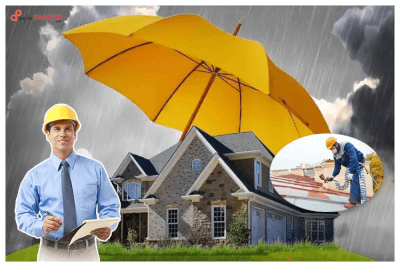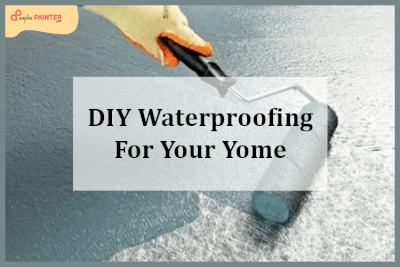Table of Contents
DIY Waterproof Your Home
Waterproofing your home can seem like a daunting task, but it doesn’t have to be! There are many ways that you can waterproof your home yourself without hiring a professional.
Yes, waterproofing your home is important, but it’s also something that you can do yourself! There are many ways to waterproof your home without hiring a professional.
However, it can be overwhelming to go with the project if it is your first time and you don’t know where to start. From identifying the affected areas to choosing the right waterproofing materials, we will guide you through the process of waterproofing your home so that you can do it yourself with ease!
In this blog post, we will discuss some of the best ways to DIY waterproof your home. We will also provide tips on how to choose the right waterproofing products for your needs. Let’s get started!

Signs that you need to waterproof your home
The first step in waterproofing your home is to identify the areas that are most vulnerable to water damage. There are a few key signs that you can look for that will indicate whether or not you need to waterproof your home:
- Water stains on ceilings or walls
- Cracks in walls, floors, or ceilings
- Mold or mildew growth
- Peeling paint
- Members of the family getting sick or developing allergies
- Bad odor
- Doors getting stuck or windows that won’t close properly
If you notice any of these signs in your home, it’s time to start thinking about waterproofing!
What Causes Water Damage?
There are many different causes of water damage. Some of the most common include:
- Leaking or burst pipes
- Heavy rains or flooding
- Leaks in the roof
- Damp basement or crawl space
- Malfunctioning appliances such as washing machines, dishwashers, or refrigerators
Water damage can be caused by a number of different factors. If you’re not sure what’s causing the water damage in your home, it’s best to call in a professional to take a look. They will be able to identify the source of the problem and advise you on the best course of action.
What is Home Waterproofing?
Home waterproofing is the process of making your home resistant to water damage. This can be done in a number of ways, but the most common methods are sealing cracks and holes, installing drainage systems, and applying waterproof coatings to vulnerable areas.
Waterproofing your home is important because it will help to protect your investment from water damage. Water damage is one of the most common causes of home insurance claims, so it’s important to do everything you can to prevent it!
Waterproofing your home will also improve the comfort of your living space by preventing mold and mildew growth. Mold and mildew can cause health problems for you and your family, so it’s best to nip it in the bud before it becomes a problem.

How to Waterproof Your Home?
If you’re interested in waterproofing your home, there are a few things you need to know before getting started. In this section, we’ll discuss a step-by-step guide to waterproofing your home, as well as some of the things you need to keep in mind.
Step 1: Have a Plan
Before starting any waterproofing project, it’s important to have a plan! This will help you to stay organized and on track throughout the process. Start by identifying the areas of your home that are most vulnerable to water damage. DIY Waterproofing : Once you’ve done this, you can begin to research the best methods for waterproofing these areas.
Step 2: Shop for Required Materials
Once you’ve identified the problem areas in your home, it’s time to start shopping for materials! There are a wide variety of waterproofing products on the market, so it’s important to do your research and choose the right one for your needs.
When choosing a waterproofing product, it’s important to consider the following factors:
- The type of surface you’re waterproofing (e.g., concrete, wood, metal, etc.)
- The location of the surface (e.g., exterior or interior)
- The severity of the water damage
- Your budget
Once you’ve considered all of these factors, you can start shopping for materials! DIY Waterproofing , You can find a wide variety of waterproofing products at your local hardware store or online.
Step 3: Prepare the Area for Waterproofing
Once you’ve gathered all of the necessary materials, it’s time to start preparing the area for waterproofing. This usually involves cleaning and repairing any damage that has already been done by water. If there are any cracks or holes in the surface, you’ll need to fill them in before applying a waterproofing product.
It’s also important to make sure that the area is free of debris before starting. DIY Waterproofing : Any dirt, dust, or other contaminants will reduce the effectiveness of the waterproofing product, so it’s important to remove them before starting.
Step 4: Apply Waterproofing Product
After preparing the area, you’re finally ready to apply the waterproofing product! This usually involves following the instructions on the packaging. Some products require multiple coats for the best results, so be sure to read the instructions carefully before getting started.
Applying a waterproofing product can be a messy job, so it’s important to wear the proper clothing and take precautions to avoid making a mess. DIY Waterproofing , Once you’ve applied the product, you’ll need to wait for it to dry before moving on to the next step.
Step 5: Test the Area
After the waterproofing product has had time to dry, it’s time to test the area! This usually involves waiting for a heavy rainstorm and seeing how well the area holds up. If there are any problems, you may need to reapply the waterproofing product or try a different method or product altogether.
Conclusion
Waterproofing your home is an important project that will help to protect your investment from water damage. By following these steps, you can ensure that your home is properly protected against water damage. Also, don’t forget to test the area after the project is complete to make sure that it’s properly protected!
